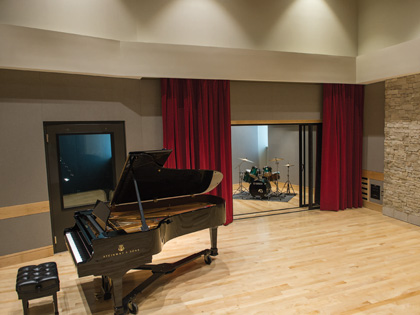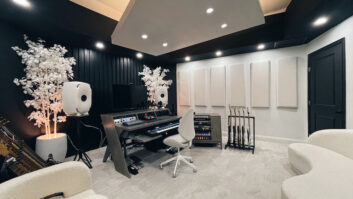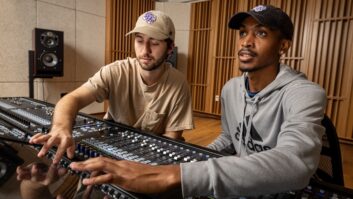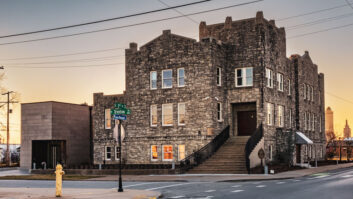
It seems so obvious that it doesn’t even need to be stated, but Music and Recording are cultural and artistic siblings, symbiotic to the point that, while each may exist in its own world at any one time, they are, at this point in history, forever intertwined. Nowhere is this more apparent than in school, where young musicians and budding recording engineers/producers bump elbows in rehearsal rooms, practice their crafts in recital halls and learn from each other in the studio, developing the skills necessary to make each other sound great.
This intermingling can happen anywhere, in any place, from a weeklong summer workshop to an elite conservatory fellowship. And it recently came together in a major way in Bloomington, Indiana, when this past June the world-renowned Jacobs School of Music opened the world-class Georgina Joshi Recording Arts Studio, pictured on this month’s cover.
While the Recording Arts and Sound Production program had numerous smaller facilities sprinkled throughout the music school, there was no “big room” to match the scale and excellence of the Jacobs School, a music conservatory within Indiana University that has attracted top faculty and students since its inception in 1921.

Inset: The construction crew installs the custom clouds
roughly 18 feet above the floor, hiding the HVAC and
offering variable trapping above.
It’s not always easy for programs within a public institution to procure the funds to build something like the Joshi Recording Studio. Bids are required for equipment and vendors, there are ethics rules of interaction, and, let’s face it, support for the arts in public education has not been a priority over the past few decades. That’s why the genesis of the studio goes back to 2006, when the Jacobs School (of which the Audio Engineering program is a part) developed a 15-year-plan of excellence, encompassing goals for innovation, faculty, facilities and entrepreneurship, to culminate in 2021, the school’s centennial year.
That plan was then presented in 2007 to philanthropy partners, and the Eli Lily Foundation, impressed with the long-term commitment to excellence, provided a $44.2 million endowment to the Jacobs School. Part of that money was earmarked for a studio within an addition to the famed Musical Arts Center, while the majority went toward the construction of the nearby East Studio Building, which contains technically and acoustically state-of-the-art faculty offices (each 300 square feet). That phase of the plan was dedicated in 2013. Meanwhile, the MAC addition took on a life of its own when the Georgina Joshi Foundation stepped in with an additional $1 million grant specifically for a recording studio.
“Georgina had a special relationship with her parents, and they fully supported their children in whatever they pursued,” says Melissa Dickson, Jacobs School executive director of external affairs, who attended the school with Joshi in the mid-2000s. “One day at their house in Michigan, Georgina was talking to her parents and said, ‘You know, what my friends really need is a recording studio, to be able to have professional demos for auditions, and so they can see what exists out there in the world.’ That really resonated with her mother and father.”
Georgina Joshi, a soprano who trained at the Royal College of Music in London for her undergraduate degree, was returning from a performance in West Lafayette, Ind., in April 2006 with four of her close friends, all top students at Jacobs, when an accident claimed all of their lives. It was devastating to the community. Since then, the Joshi family of South Bend, Ind., has donated more than $4.2 million to the Jacobs School to specifically honor their daughter’s passions, including the endowment of a Handel early music series, an international fellowship program, a recital hall for the South Bend campus, and a Five Friends Master Class Series emphasizing each of the disciplines favored by her and her colleagues.
Konrad Strauss, a Jacobs alum in composition and now Chair of the Department of Audio Engineering and Production, had been instrumental in developing the plan originally presented to the Lily Foundation. With the generous gift from the Joshi family, he says, we were able to build a truly world-class recording studio adjoining the two large, orchestra-scale rehearsal spaces in the Musical Arts Center addition.
THE CONTROL ROOM AND THE STUDIO


Top: The view from the control room, through the side glass to the studio. Bottom: Assistant professor Michael Stucker, who led the integration, is shown directing students in the installation of the ATC monitors.
“When I started here 16 years ago, I knew that someday we would be able to upgrade our studios, but I never expected anything like this,” Strauss says. “We wanted the studio to serve two purposes: We wanted a great facility for our students to work in, where they can exercise their craft and make good recordings, something that was representative of the great studios of the world, with traditional iso booths, the best equipment and an ambient space that suited all styles of music—jazz band, quartet, classical chamber group, rock band, horn section. The studio has to fill all those roles.
“We also wanted a teaching facility, a control room with enough space to fit students and not be crowded,” he continues. “And we wanted a control room with first-rate, even monitoring so we could play back recordings at a high quality and judge and analyze them. We wanted a high-end, 7.1 listening room, and we hadn’t had that before.”
Knowing that they had a defined space with high ceilings within the MAC addition, Strauss and his colleagues on the faculty began on the layout, working hand in hand with Robert Lee of BAI, an architecture and acoustics firm in Austin, Texas. The control room orientation was rotated to be more horizontal, with side-facing glass into the studio. An ATC soffit-mounted monitor system was selected early on in order to optimize the design approach. And, late in the game, an Avid S6 control surface with high-end analog front end was chosen over a traditional in-line analog console, the idea being that students were more likely to encounter a hybrid workflow once they left Jacobs, and they already had an Audient board in another studio to teach analog signal flow.
“Most studios are going hybrid today,” Strauss says. “After sitting with the S6 and working on it, it felt very natural to me, and we felt that it was something the students would embrace. Then once we decided to go with a control surface, we thought, ‘Now let’s look at a classic analog front end.’ We looked at analog gear that we felt they would encounter out in the field. That’s why we have the Neves, the APIs, the 1176s, the Pultecs, the Tube-Techs, the LA-2A, the SSL and Neve 500 Series modules. Great-sounding gear that students will definitely encounter in professional studios. So we have a high-end analog front end, with a variety of flavors students can choose from when they’re making their mic selection, then into Pro Tools, then mixing. I was worried that the students would all continue to mouse around, but no. They’re at the console and spending their time learning how to use it and work tactilely, moving several faders at a time.”
“We started by thinking of the room, not necessarily the gear,” adds Assistant Professor Michael Stucker, who led the electronics integration in the control room, working with three students over the past summer. “The whole front wall was built for the ATCs. Main monitoring is coming back in style; putting the speakers in soffits keeps them off the floor, leaving more room to move around the studio. Perhaps the biggest difference, though, is the position of the equipment racks to the side of the S6; we wanted students to be able to see what is going on. If we had used a credenza, the equipment would face away from the student seating area.”
“We have a diffuse back wall, more of an old-school design because it’s an old-school control room,” adds Strauss, noting that there is room for 20 students in the rear. “Above the clouds is a big bass trap, with a hole pattern. The rear wall and front wall contain bass traps, accessed above the clouds via a perforated plywood panel that’s tuned to the room. It’s a great place to talk and teach. And it has incredibly accurate monitoring.”

The wall-within-wall construction of the live room, which allows for HVAC returns and 4-inch hanging batts for trapping low end that enters from the open space at the top of the inside wall.
The left-center-right ATCs are supplemented by QSC surrounds for a 7.1 monitoring system. Input/output is via an Avid matrix, while a Trinnov D-MON system engages room optimization for variable listening environments, again for teaching purposes. The room is wired for immersive sound; ceiling speakers are likely to be added soon.
The live room, meanwhile, follows a classic design approach, with irregular non-parallel walls, a bulkhead, high ceilings, clouds and three iso booths. Again, it had to be suitable for multiple and varied styles of music.
“Robert [Lee, of BAI] really hit a home run. We wanted it to be able to fit 20 musicians or more, and we have that,” Strauss explains. “But more importantly, we wanted an ambience that was appropriate for anything from rock ’n’ roll drums to a string quartet. We wanted three isolation booths: one fully damped for drums, a piano booth large enough for the [Hamburg Steinway] grand piano. Then a small vocal booth, which can double for upright bass on jazz. And a closet for storage! You have to have storage.”
The clouds in the ceiling are custom quad fusors that both break up early reflections and allow for more cubic feet up above to go with any future treatments and hide the HVAC feed. “I was kind of floored at the cost of the HVAC,” Strauss laughs. “But the great thing is that the air handling is two rooms
away—an incredibly long run coming here, so there is no transmission. And as far as I can tell, it’s completely silent. I set up a cellist and a pianist with a stereo pair. We got sounds, I started rolling, and I didn’t hear a thing. I thought it wasn’t working. When they started playing, there was no ambient noise in the studio.”
All floors are floated and isolated. The north and south walls (one of which features a section of local Indiana limestone) are essentially double walls, with a sound blocking wall against the concrete. Then there’s a cavity to contain the duct returns, with grilles near the floor and a 12-inch opening at the top of the interior wall to serve as a bass trap. A series of 4-inch batts hang loose within the cavity, about 18 feet, to absorb and help control the low end. Behind all the fabric, the walls themselves are covered by Real Acoustic Fast Panels, a perforated wood board on top of two inches of 704 or 706 insulation. “It’s both absorptive and reflective, so it helps control the space without killing the ambience,” Strauss says. “The room just sounds fantastic.”
THE STUDENTS

The room layout begins to take shape as the floating floors are laid down.
The Recording Arts Program accepts only 20 students per year. There is no performance requirement or audition, though a 15 credit-hour concentration in an outside field is required, the most common being music composition and performance; others include media studies, game audio, informatics and computer science, and business. Two semesters of music theory are also required, and freshmen and sophomore years are primarily devoted to audio basics and electronics, though students begin working on recording projects from day one.
“We believe very strongly in hands-on practice, doing the craft day-in and day-out,” Strauss explains. “So our students provide audio production for all Jacobs School events, all the performances and recitals that take place here, more than 500 a year. For a music student coming in as a violinist, they join the orchestra. The audio student’s ensemble is the audio crew.”
The focus in the first two years on analog electronics is particularly noteworthy. In a curriculum designed by Stucker, students begin by learning how to solder, and to analyze and build simple circuits. That’s followed by more intense concentration on audio equipment design and construction, with the ultimate goal being an advanced knowledge of troubleshooting. “When I first designed the curriculum nearly 20 years ago, I figured that this was like music theory for audio students,” Stucker says.
Juniors and seniors take on more project-based learning in the curriculum, and serve as leads on the recording crews, guiding the first year students. The emphasis on peer-based learning
is buttressed by peer-based networking. The new studio, now in its first semester of use, “has already made me a better engineer,” one student said. “I put mics up the way I usually do, and it just sounds better from the start.”
The Jacobs School of Music 15-year plan of excellence, reflected magnificently in the opening of the Georgina Joshi Recording Studio, has from the outset been focused on students and faculty, providing them with the resources to not just become proficient in their fields, but to become leaders.
“It used to be that students would come in to a school of music and then go get a job,” says Dickson, the executive director and friend of the Joshi family. “Now when you come here, we want you to go out in the world and help define your profession.”

Treatment in the piano iso booth includes alternating squares of absorption and diffusion, clouds in the ceiling, and a slice of natural light.






